Sustainability
Employee
From Stability to Challenge: A Human Resource Strategy to Pioneer the Future
Leveraging the solid business foundation we have built over many years, the Tokuyama Group is now taking on the major challenge of transforming its business portfolio. The key to achieving this lies in talent equipped with creativity and diversity, who embrace change and continue to take on challenges. We will shape the future through the power of people and organizations.
The Tokuyama Group regards human resources as its most important management capital essential for sustainable growth. Based on this belief, in 2019 we specifically defined universal expectations for the kind of employees who will help realize our Vision, as well as the direction of their growth, in our Human Resources Policy. Since then, to keep pace with the ever-changing business environment, we have formulated human resources strategies aligned with our management strategy and have steadily implemented various measures under the resolutions and oversight of the Executive Committee and the Board of Directors.
For many years, we have built a stable business foundation through our traditional businesses such as chemicals and cement. However, going forward, we must reliably achieve the major challenge of transforming our business portfolio. To accomplish this, it is essential to shift away from a mindset premised on past stable growth and to foster and secure talent capable of taking on more creative challenges. In addition, we will actively recruit individuals with diverse knowledge and experience and establish systems and a culture that value diversity across the Group, thereby building an organization resilient to change.
Furthermore, we place great importance on creating a working environment and corporate culture in which each employee can feel motivated, enthusiastic, and contribute autonomously to our efforts. Through these initiatives, we aim to enable employees to take actions that embody our strategy and to increase corporate value through their growth.
We will continue to steadily execute human resources strategies based on our management strategy and realize human capital management that earns the trust of all stakeholders while enhancing corporate value.
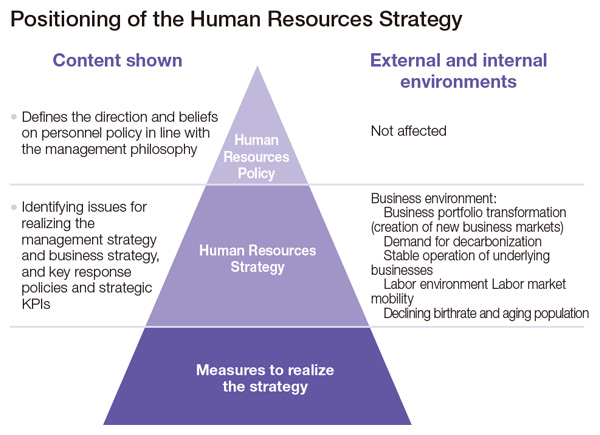
Human Resources Policy
Tokuyama Group Human Resources Policy
Revised June 2023
Established May 2019
The Tokuyama Group regards human resources as a crucial form of "management capital" necessary for sustainable growth. In this Tokuyama Group Human Resources Policy, we set out our expectations and direction of growth for our officers and employees in realizing the Tokuyama Vision, while at the same time committing to providing them with maximum support for their success.
The company regards employees as:
- Individuals recruited for their future potential who will grow through investment in education and experience and produce higher value and returns.
- Individuals who pursue expected roles and outcomes, value teamwork, and enjoy their work.
- Individuals who find motivation in the opportunities for achievement in their work, their own growth, and the growth of the Tokuyama Group.
- Individuals capable of self-management through autonomous actions.
Regarding the growth of its employees, the company:
- Seeks contributions to society and the company by each employee forming a career that aligns with the diversity of each employee's work style under the equal opportunities provided.
- Requires managers not only to have the skills to efficiently utilize resources to achieve goals but also to exercise strong leadership to engage others in creating new value.
- Demands execution of “What to Do” — contemplating what we should provide to our customers. Furthermore, for those who are supervisors, it demands the pursuit of “Why” — being able to articulate in their own words to members why we do what we do and what we aim to accomplish.
The company provides its employees with:
- A human resource development framework that enables individuals to grow and meet company expectations, creating a competitive workforce and organization that take on and overcome challenges.
- A system in which human resources who continue to grow can continue to contribute with assurance for as long as possible.
- Fair evaluation of individuals based on their roles, the results they have produced, and their conduct befitting a Tokuyama Group employee, as well as appropriate treatment.
Developing Talent to Lead the Future — Tokuyama's Education Framework
We regard the development of talent who embraces challenges as a driving force for corporate growth. In addition to a systematic education program that combines OJT (on-the-job training) and OFF-JT (off-the-job training), we are actively promoting strategic investments in human capital to foster next-generation leaders and cultivate diverse talent.
Tokuyama promotes a systematic approach to human resource development by combining the enhancement of skills and mindset through daily work via OJT with hierarchical and specialized training through OFF-JT. In OFF-JT, in addition to rank-based training under the role-qualification system, we provide compliance education aimed at fostering cultural reform and ensuring legal compliance, as well as specialized education for technology transfer, safety management, and business transformation. We also support employees' self-development and encourage autonomous growth by subsidizing the cost of obtaining public qualifications and correspondence courses.
Furthermore, as part of developing talent to support business portfolio transformation, we conduct the "Next Business Leader Training (NBL Training)" program for future management candidates. Since its launch in fiscal 2018, approximately 70 employees have completed the program by fiscal 2024, including diverse talent such as mid-career hires and women.
The program leverages external resources in a practical and proactive manner, emphasizing outward-looking content. Some graduates of the program are now subject to strategic rotations under the new personnel system introduced in fiscal 2025, with the aim of accelerating their development into management leaders. Going forward, we will continue to foster talent that can take on challenges and create an environment where they can thrive, thereby supporting the company’s sustainable growth.
(Example)
Next-Generation Leader Development (NBL Training)
This program is designed to accelerate the development of future "management talent" who will drive the company's growth. The requirements for management talent are defined as: "having a thorough understanding of the company and business mechanisms, possessing high aspirations and deep insight, envisioning the future of the company and its businesses, creating business models, and having the decisiveness, execution capability, and personal credibility to make things happen." Participants acquire the necessary skills through a combination of diverse training programs and practical experience.
Global Talent Development
Tokuyama is promoting the transformation of its business portfolio to become a value-creating company with a global presence. To develop global talent, we provide education on language and cross-cultural understanding from the time of joining the company through to overseas assignments. This is achieved through a combination of self-learning and structured training programs (PG), creating a system that encourages employees to take on challenges proactively. Among these, the selective "Practical English Proficiency Enhancement Program" defines global talent as individuals who: Embrace the local business environment and customer culture at their assignment location and contribute to social and economic development, and possess the mindset to take on challenges in cutting-edge markets. The program focuses on strengthening the skills necessary to achieve these qualities.
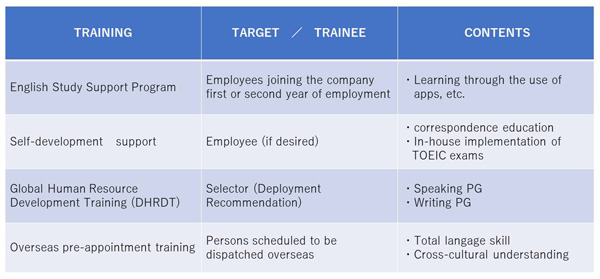
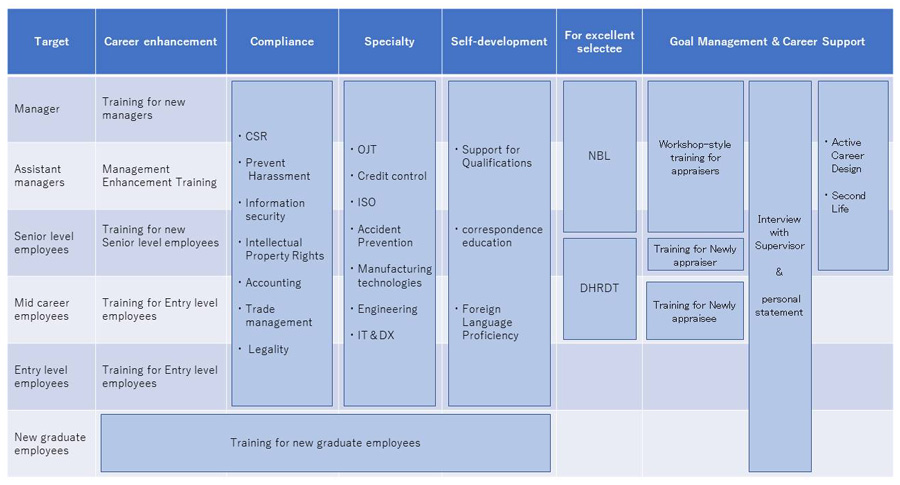
Supporting Challenge and Contribution — Tokuyama's Human Resource System
As part of its talent strategy to support sustainable corporate growth, Tokuyama implemented a comprehensive revision of its human resource system in May 2025. The new system is designed to enable employees who embrace challenges to fully demonstrate their capabilities by shifting to a framework that rewards the value and results of their work.
In May 2025, Tokuyama implemented a comprehensive revision of its human resource system as part of a talent strategy aligned with its business strategy, designed to support the development and growth of employees who embrace challenges. Under the concept of "Pay for Job," the new system shifts from age- or attribute-based treatment to a framework that rewards the value and results of the work performed.
This reform eliminates age-based pay and personal allowances, establishing a system grounded in fair evaluation and treatment based on performance and behavior, with the aim of enhancing job satisfaction and maximizing corporate value. In addition, allowances such as family allowances—previously received primarily by male employees—have been abolished to ensure equitable treatment regardless of gender, while reinforcing a compensation structure based on individual results and promoting greater opportunities for women.
Furthermore, a dual-track career system has been introduced to reflect job type and responsibilities, along with mechanisms to encourage ambition, such as incentives for employees participating in strategically important projects. The required tenure for promotion to each qualification grade has also been shortened, enabling the early advancement of high-performing young employees and helping those who have taken maternity or childcare leave to recover career progression.
Through this system, which ensures fair evaluation of performance and behavior, we aim to boost employee motivation and engagement, enabling high-performing talent to drive business growth with greater productivity. By creating an environment where employees who embrace challenges can thrive autonomously, Tokuyama will continue to strengthen its foundation for sustainable growth and enhance corporate value as a driving force for the future of the Tokuyama Group.
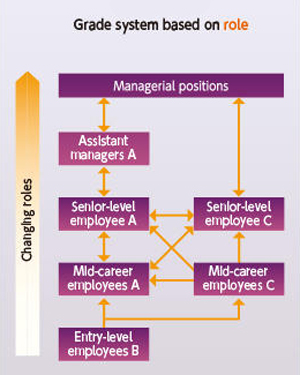
Promoting Diversity
Tokuyama is committed to fostering a vibrant and inclusive workplace where all employees can work energetically and achieve success. We place a high value on diversity of knowledge and wisdom, and through ongoing organizational culture reform, we strive to create workplaces that are both pleasant and motivating, while also aiming to enhance productivity.
The Company actively pursues a target of at least 20% female representation among new hires (university graduates and above) each year. In line with this, we are also implementing continuous measures to achieve a future goal of 20% female representation across the entire workforce.
In 2025, we revised our compensation system to establish a fair framework based on job performance, regardless of gender. This initiative is helping to correct disparities in treatment between men and women, and we will continue to pursue further improvements going forward.
As Tokuyama Co., Ltd., we have formulated an Action Plan based on Japan's Act on the Promotion of Women's Active Engagement in Professional Life, and are working to achieve the following targets by the end of March 2028, including the percentage of women in managerial positions:
①Maintain a female hiring ratio of 20% or more for university graduates and above (three-year moving average)
②Aim for 6% or more women in managerial positions (section manager level and above)
③Maintain an annual paid leave utilization rate of 75% or more for all employees
To achieve these goals, we are striving to create a work environment that is supportive for women. Specific initiatives include implementing e-learning programs to raise awareness of unconscious bias, creating a "Guide to Maternity and Childcare Leave" to encourage male employees to take childcare leave, and providing training for female employees on health issues unique to women. In addition, through "Tokuchalle" activities, we promote themes that contribute to a gender-neutral work environment, such as "Working Parents! Everyone's Tokusapo."
The table below can be scrolled horizontally
| Tokuyama Targets to Promote Opportunities for Women | ||||||
|---|---|---|---|---|---|---|
| Target | Target Value (FY2025) |
Performance (April 2021) |
Performance (April 2022) |
Performance (April 2023) |
Performance (April 2024) |
Performance (April 2025) |
| Percentafe of women among university graduates who are hired |
No less than 20% (3-year moving average) |
21.00% | 21.00% | 20.50% | 25.70% | 25.64% |
| Percentafe of women among all managers | No less than 5% | 2.00% | 2.00% | 2.70% | 2.70% | 2.88% |
| Average usage rate of annual paid leave (since2020) |
75% | 75.20% | 75.80% | 74.20% | 78.20% | 87.70% |
Furthermore, to accelerate the promotion of women's participation across the Tokuyama Group, we have set a voluntary goal to increase the ratio of female managers to 15% or more by fiscal year 2030.
To foster an organizational culture where diverse talents can thrive, we conduct lectures on the importance of diversity as part of our new employee training program. With respect to the employment of persons with disabilities, the Company strives to achieve the statutory employment rate and is working to develop the workplace environment, including accessibility through barrier-free initiatives. We have also launched new initiatives, including opening You You Terrace as a facility for people with disabilities and establishing the agricultural corporation Tokuyama You You Farm Co., Ltd., which supports the independence of people with disabilities and contributes to the local community.
Work-Life Balance Support Programs
At Tokuyama, employees in workplaces eligible for flextime can choose their workday schedules with no core work-period requirement. The Company is also striving to optimize working hours by tracking and presenting aggregate data based on thecomputer log details of employees, enabling actual working conditions to be managed.
Under a program to help employees balance work and childcare responsibilities, eligible employees can use shortened working hours from 10 weeks before childbirth until the child starts elementary school, *1 and can also use flextime from the time that pregnancy is determined until the child reaches sixth grade. Paid parental leave is available from birth until the infant reaches age one. Tokuyama provides eligible employees and their managers with paid parental leave information to facilitate the use of leave. Childcare leave is also available until the infant reaches age two.*2 As a result of these various efforts, we received "Platinum Kurumin Certification" from the Minister of Health, Labor and Welfare on July 19, 2022, as an excellent childcare support company.
The uptake of parental leave and childcare leave among male employees is also becoming more established, with over 100 employees taking such leave each year.
Employees can also take family care leave for up to two years (legal requirement: 93 days in total) for each family member requiring care. With family care time off (unpaid), regardless of the number of care recipients, it is possible to take off two days a week (legal requirement: five days a year).
To support those on childcare and family care leave and help them eventually make a smooth transition back to work, internal information is shared with them on the intranet. In addition, an employee reinstatement system has been established to allow employees who resigned for childcare or family care reasons to be rehired.
*1. Legal requirement is the age of three.
*2. Legal requirement is the age of one. In certain cases, leave can be taken until the child reaches age two.
The table below can be scrolled horizontally
| Annual Paid Leave Usage and Non-scheduled Working Hours | |||||
|---|---|---|---|---|---|
| FY2020 | FY2021 | FY2022 | FY2023 | FY2024 | |
| Annual paid leave, average days used |
15.3 days | 15.5 days | 14.9 days | 14.1 days | 17.2 days |
| Annual paid leave, average usage rate |
75.2% | 75.8% | 72.8% | 78.2% | 84.4% |
| Total working hours per year |
1,879.0 hours | 1,909.3 hours | 1,911.6 hours | 1,889.9 hours | 1,877.2 hours |
| Non-scheduled working hours, average per month |
10.3 hours | 11.1 hours | 11.7 hours | 11.4 hours | 11.6 hours |
| ※ All non-consolidated | |||||
The table below can be scrolled horizontally
| Usage of Childcare and Family Care Leave, Etc. | |||||
|---|---|---|---|---|---|
| FY2020 | FY2021 | FY2022 | FY2023 | FY2024 | |
|
Number of employees taking childcare leave |
23 | 21 | 34 |
M:41 F:8 |
M:43 F:12 |
| Retumn to work rate | 100.0% | 100.0% | 97.1% |
M:98.0% F:100.0% |
M:100.0% F:92.0% |
|
Number of employees taking parental leave |
100 | 94 | 112 |
M:97 F:0 |
M:90 F:0 |
|
Number of employees taking family care leave |
1 | 1 | 2 |
M:0 F:0 |
M:1 F:0 |
|
Number of employees toking family care time off |
1 | 3 | 1 |
M:0 F:0 |
M:1 F:1 |
| Number of flextime users | 48 | 65 | 73 | 88 | 79 |
| ※ All non-consolidated | |||||
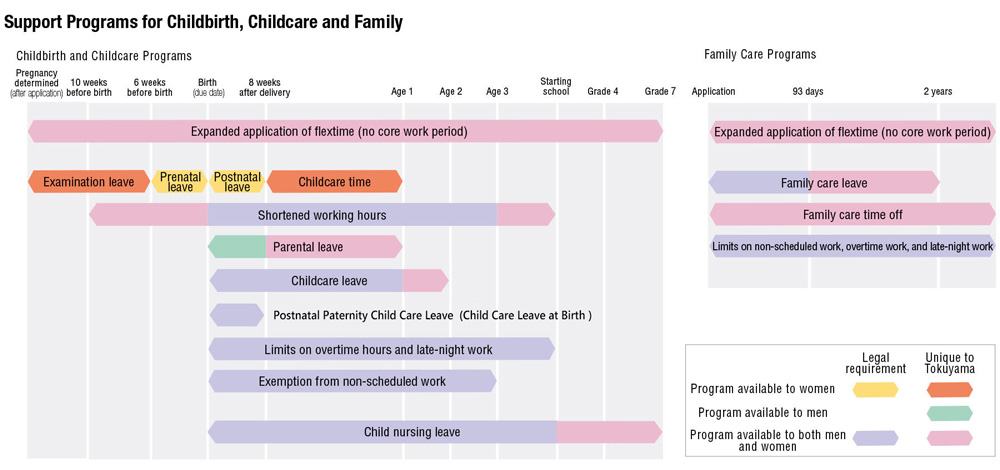
| Category | Program | Details | |
|---|---|---|---|
| Flextime system | Employees eligible for flextime can freely select work schedule (no core work period) | ||
| Childbirth and childcare | Flextime eligibility | An employee raising a child in sixth grade or younger, but who is not eligible for flextime, can apply for transfer to a workplace where flextime is available, making the employee eligible for flextime. | |
| Expanded application of flextime | Employees who are pregnant or raising a child in sixth grade or younger can work shortened hours below the prescribed monthly work hours, and can work intermittently with interruptions and resumption of work. | ||
| Examination leave | Leave taken by a pregnant employee to receive health guidance or medical exams shall be paid one day per month from pregnancy to 23 weeks and two days per month from 24 weeks to prenatal leave. | ||
| Prenatal and postnatal leave | Paid leave can be taken for up to six weeks before childbirth (14 weeks for a multiple-child pregnancy), and up to eight weeks after childbirth (law only requires unpaid leave). | ||
| Childcare time | A female employee raising a child younger than one year old can take 30 minutes of childcare time twice a day (paid). | ||
| Shortened working hours | An employee expecting a child within 10 weeks or raising a preschool child can shorten the work day by one to two hours per day. | ||
| Parental leave | An employee with a newborn can take eight days within one year of the birth. | ||
| Childcare leave | An employee can take up to 10 days of paid leave within one year after the birth of a child. | ||
| Postnatal Paternity Child Care Leave (Child Care Leave at Birth ) | An employee can take up to four weeks of childcare leave within eight weeks of the birth of a child. (can be divided into two periods of leave) | ||
| Accumulated annual leave * |
・Employees raising children in the sixth grade or younger can use the accumulated annual leave if they need to take 5 or more days off due to school or class closures, etc. caused by natural disasters or infectious diseases such as influenza. ・An employee who is pregnant or post-partum and has been instructed by a doctor or other health professional to take time off work, or an employee who requires time off due to infertility or infertility treatment. |
||
| Limits on overtime and late-night work | An employee raising a preschooler can apply to limit after-hours and late-night work. | ||
| Exemption from non-scheduled work | An employee raising a child younger than three can apply for exemption from non-scheduled work. | ||
| Reinstatement registration system | An employee who resigns for the reason of pregnancy, childbirth, or childcare can register for this rehiring program upon resignation. | ||
| Support payment for childcare leave | Employees who took full of childcare leave can receive a half of bonus standard wage as support payment. The payment could be also received if an employee take unpaid prenatal and/or postnatal leave without reinstatement from childcare leave. |
||
| Regular health exams | An employee can receive paid leave to receive regular medical checkups after taking prenatal/postnatal leave, or childcare leave. | ||
| Child nursing leave etc. | For employees raising children up to the sixth grade of elementary school, up to five days of unpaid leave per person per year (which may be taken in hourly units) can be taken for the purpose of caring for a child's injuries or illnesses, or for immunizations and health checkups. In addition, employees raising preschool children are entitled to three days of paid leave per year (which cannot be taken in hourly units), regardless of the number of children. This paid leave may also be used, within the annual limit of three days, for attending entrance and graduation ceremonies for nursery school or elementary school. |
||
| Family care | Flextime eligibility | An employee not eligible for flextime but who has a family member needing care can apply for transfer to a workplace where flextime is permitted, and receive flextime. | |
| Expanded application of flextime | Upon application, an employee with a family member needing care can work shortened hours below the prescribed monthly work hours, and can work intermittently with interruptions and resumption of work. | ||
| Family care leave | Can be taken for up to two years for each care recipient. | ||
| Family care time off | When a person with a family member in need of nursing care requests nursing care leave, regardless of the number of family members in need of care, he or she can take two days per week (maybe subdivided into hourly units) of (unpaid) leave. (However, in the case that two days per week are taken, one day can be used from accumulated annual paid leave.) | ||
| Accumulated annual leave * | Accumulated annual leave can be used for a family care leave if the leave took more than 5 days. | ||
| Reinstatement registration system | An employee who resigns in order to care for a family member can register for this program at the time of resignation. | ||
| Support payment for family care leave | Employees who took full of family care leave can receive bonus standard wage as support payment. | ||
| Limits on non-scheduled work, overtime work,and late-night work | An employee with a family member needing care can refuse non-scheduled and after-hours work (latenight work limit is available to an employee with a family member requiring care, and who lives in a household without someone else, 16 or older, to provide the needed care). | ||
| Volunteer | Accumulated annual leave * | Leaves that can be used for volunteer relief work in a major disaster | |
| Working from home |
Working from Home A:
If the employee requests it and the company approves, in principle two days a week may be spent working from home.
Working from Home B:
If employees are experiencing problems arising from nursing care or childcare obligations that cannot be solved by using Working from Home A, the short working hours system, or the flexible operation of flextime, working from home can be used up to four days a week.
Temporary Working from Home:
When it is necessary to work from home beyond the abovementioned scope due to the impact of natural disasters or from the perspective of preventing infectious diseases, etc., the General Manager of the General Affairs & Human Resources Division shall make the decision on whether to allow working from home.
A telecommuting allowance of ¥2,500 per month is paid to employees who work at office two or fewer days per week. |
||
* A cirtain number of accumulated annual paid leaves that have expired.
※ Examination leave, prenatal and postnatal leave, and childcare time are programs exclusively for women
Employees Data
The table below can be scrolled horizontally
| Tokuyama Group Employees (Consolidated) | |||||||
|---|---|---|---|---|---|---|---|
| Unit | FY2020 | FY2021 | FY2022 | FY2023 | FY2024 | ||
| Number of employees(fulltime) | non-consolidated | persons | 2,256 | 2,315 | 2,459 | 2,520 | 2,593 |
| consolidated | 5,476 | 5,665 | 5,909 | 5,734 | 5,782 | ||
| Ratio of women(fulltime) | non-consolidated | % | 9.5 | 9.2 | 8.7 | 8.5 | 13.2 |
| consolidated | ― | ― | 16.4 | 17.5 | 18.0 | ||
| Number of employees(part-time) | non-consolidated | persons | 0 | 0 | 0 | 2 | 2 |
| consolidated | 449 | 432 | 449 | 455 | 475 | ||
| Percentage of women among all managers*1 | non-consolidated | % | 2.0 | 2.0 | 2.7 | 2.7 | 2.9 |
| consolidated | ― | ― | 4.7 | 8.2 | 7.9 | ||
| Percentage of male employees taking parental leave | non-consolidated | % | ― | ― | 26.5 | 51.3 | 57.3 |
| consolidated | ― | ― | 28.4 | 47.3 | 7.9 | ||
| Ratio of wages between men and women | non-consolidated | % | ― | ― | 68.3 | 69.2 | 70.2 |
| consolidated | ― | ― | 67.0 | 55.3 | 54.0 | ||
| *1 Including those in managerial positions such as contract-based managers | |||||||
The table below can be scrolled horizontally
| Tokuyama Employees (Non-consolidated) | |||||||
|---|---|---|---|---|---|---|---|
| Unit | FY2020 | FY2021 | FY2022 | FY2023 | FY2024 | ||
| Number of New hires | Men | persons | 69 | 64 | 62 | 124 | 190 |
| Women | 13 | 15 | 15 | 23 | 34 | ||
| Total | 82 | 79 | 77 | 147 | 224 | ||
| Percentage of women among university graduates who are hired |
% | 21 | 21 | 20.5 | 26.0 | 22.0 | |
| Number of midcareer hires | Men | persons | 79 | 49 | 49 | 50 | 48 |
| Women | 7 | 3 | 6 | 3 | 10 | ||
| Total | 86 | 52 | 55 | 53 | 58 | ||
| Number of rehired individuals*1 | Single year | persons | 35 | 65 | 71 | 62 | 71 |
| Total | 132 | 186 | 224 | 253 | 289 | ||
| Average age | Men | years old | 41.8 | 41.6 | 41.5 | 41.5 | 41.6 |
| Women | 39.8 | 40.1 | 40.0 | 40.0 | 40.2 | ||
| Average | 41.5 | 41.4 | 41.3 | 41.3 | 41.4 | ||
| Average salary | Yen | 7,358,747 | 7,221,001 | 7,041,706 | 6,826,985 | 7,320,644 | |
| Average years of service | Men | years | 18.7 | 18.3 | 17.7 | 17.6 | 17.7 |
| Women | 12.4 | 12.8 | 12.3 | 12.3 | 12.2 | ||
| Average | 17.9 | 17.6 | 17.0 | 16.9 | 17.0 | ||
| 3-year retention rate | % | 90.9 | 92.7 | 98.8 | 94.8 | 90.0 | |
| Turnover rate for personal reasons*1 |
Men | % | 0.91 | 1.33 | 1.4 | 1.5 | 1.8 |
| Women | 1.03 | 1.92 | 1.3 | 3.7 | 2.0 | ||
| Average | 0.92 | 1.41 | 1.3 | 1.8 | 1.8 | ||
| Employment rate of people with disabilities | % | 2.02 | 2.01 | 2.00 | 2.29 | 2.34 | |
| Number of non-Japanese employees | persons | 15 | 9 | 10 | 15 | 16 | |
| Average annual training cost per employee | Yen/persons | 9,000 | 20,000 | 45,000 | 25,794 | 33,166 | |
| Average hours for training per employee | hours | ― | 14.3 | 13.8 | 13.5 | 13.1 | |
| Number of labor union members [Labor union membership rate] |
persons [%] |
1,734 [76.9] |
1,746 [75.4] |
1,817 [73.9] |
1,862 [82.4] |
1,898 [73.2] |
|
| *1 Includes workers assigned to group/affiliate companies ※ All non-consolidated | |||||||

